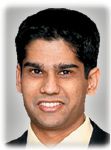Article
FSH should not be factor in mTESE patient selection
Elevated serum follicle-stimulating hormone does not predict a lower sperm retrieval rate for men with nonobstructive azoospermia undergoing microdissection tesÂticular sperm extraction, and should not be considered a contraindication for this fertility procedure.

The analyses were based on data from 792 consecutive men with NOA who underwent their first mTESE by a single urologist between 1999 and 2006. The sperm retrieval rate in the subgroup of men with an FSH above 15 IU/mL was significantly higher compared with all men with an FSH ≤15 IU/mL (62% vs. 51%). When the men were stratified based on 15 IU/mL increments of FSH (≤15, 16-30, 31-45, and ≥45), sperm retrieval rates in the three highest FSH subgroups ranged from 61% to 66%, and each was significantly higher than the rate in the subgroup of men with an FSH of 15 IU/mL or below, reported first author Ranjith Ramasamy, MD, a urology resident at Weill Medical College.
"FSH has been studied as an important preoperative serum parameter to predict outcomes in TESE, and in various studies of this procedure, elevated FSH has been associated with a low probability for sperm retrieval in men and lower pregnancy rates in their female partners," he noted.
The surgeries were performed by senior author Peter N. Schlegel, MD, professor and chairman of urology at Weill Medical College. In the procedure, the tunica albuginea is opened and then the testicular parenchyma is examined directly at 15X to 25X magnification to include as much of the parenchyma as possible. Blood vessels are identified and ligated, and small samples are excised from the larger, more opaque tubules visualized under the operating microscope.
"Most areas of the testicular parenchyma are examined until areas of spermatogenesis are found," Dr. Schlegel explained. "Therefore, the number of areas sampled per testis is greater for a larger testis than for a smaller one."
Prior to undergoing mTESE, all men had confirmation of azoospermia in an ejaculated semen specimen obtained on the day of planned sperm retrieval during a programmed IVF cycle. In addition, per World Health Organization guidelines, they had azoospermia in two semen analyses prior to the day of the procedure.
"We do an additional semen analysis on the operative day because we find sperm in up to 10% of our patients," Dr. Ramasamy said.
The investigators also analyzed whether other baseline characteristics offered predictive value. Biopsy histology, testicular volume, and male age had no effect on sperm retrieval rates for mTESE. Interestingly, however, among men with FSH ≤15 IU/mL, testicular volume was significantly greater compared with the other three subgroups (12 vs. 6-9 mL), and a significantly higher proportion of the men with the lowest FSH had maturation arrest (38% vs. 16%-28%). The proportion of men with Sertoli cell-only histology was also lower in men with FSH ≤15 IU/mL than that of the other three subgroups (34% vs. 50%-68%).
"We have already published a study that showed a subset of men with normal FSH, normal-size testis, and diffuse maturation arrest on histology have a higher prevalence of chromosomal abnormalities with lower sperm retrieval rates," Dr. Ramasamy explained. "In addition, on closer inspection of our data, we found men with Sertoli cell only histology and larger-volume testis often have lower FSH levels. This lower FSH may be a reflection of the larger number of Sertoli cells in a larger testis providing more control feedback to suppress FSH production."
Combining FSH and biopsy resulted only in a fair prediction model of sperm retrieval success with mTESE (area under the receiver operating curve: 0.71). This model performed significantly better than did either FSH or biopsy histology alone, Dr. Ramasamy said.
Newsletter
Stay current with the latest urology news and practice-changing insights — sign up now for the essential updates every urologist needs.
















